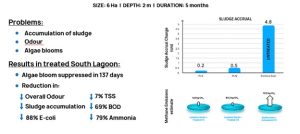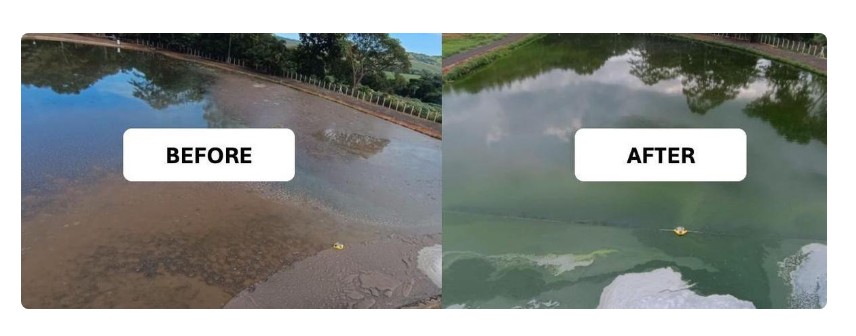Tonnes of sludge or biosolids are produced per year that must be managed, either through beneficial reuse (e.g. land application), incineration, or disposal in sanitary landfills. Volume reduction can mitigate the operational costs of wastewater management, as well as the environmental costs associated with disposal pathways. Treatment approaches to reduce volume, as well as to enhance nutrient recycling and energy recovery, include thickening and dewatering, composting, drying, and digestion
Open-body lagoons systems are designed for primary wastewater treatment, particularly in rural areas, and are designed specifically for digestion of sludge to reduce volume and recycle nutrients. In many other parts of the world, lakes and ponds function as sewage treatment lagoons – although, often not by intention. In Brazil, only 40% of domestic sewage is properly treated, and much of the untreated waste is diverted to surface water1. Additionally, in the face of climate change, the occurrence of sewage overflows due to intense rainfall and storm events are only going to increase. The challenges associated with sludge management and overflow are not isolated cases in the world but rather an example of a much broader, global environmental health and public safety challenge.
Sludge digestion in sanitary lagoons occurs through a combination of aerobic and anaerobic processes. Anaerobic processes may serve in stabilization of sludge prior to safe reuse or disposal. Aerobic processing, however, is generally more efficient in removal of organic carbon and associated volume reduction. Though it may be more desirable to enhance aerobic metabolism in sanitary lagoons, it is not simple in a system that, by design, has high organic carbon and nutrient loading. Furthermore, maintaining a steady aerobic metabolic state requires a constant stream of oxygen delivery. Mechanical aeration is the most common solution to enhance aerobic activity in stagnant bodies of water but the energy, maintenance and financial costs in maintaining aerators on a 24 hour basis can be astronomical.
After 10 years of R&D, EM Fluids has developed an equilibrium modulating technology to alter the properties of water on a large scale with minimal energy input. Devices are solar-powered, self-contained systems that enhance the gas transfer rate across the air-water interface — achieved without chemicals or mechanical agitation. A set of pre-calibrated stimuli (<1W) initiates changes in the liquid equilibrium structure of the waterbody which leads to changes in associated physicochemical properties, including, but not limited to, surface tension and viscosity. A reduction of surface tension and viscosity has shown a doubling in the gas transfer rate – gasses like oxygen – across the air-water interface. The applications of this technology include: low cost oxygenation of very large waterbodies and improving wastewater processing, including sludge management, malodours, and meeting effluent water quality standards.
The proposed EMF Device is a novel aeration solar-powered technology that does not require permanent infrastructure and is deployed as a small buoy. The proposed technology is a new approach to digest organic matter in situ as part of regular operations, whether you manage a municipal lagoon, industrial treatment site, or agricultural wastewater system.
Main image shows the before and after implantation of a sewage lagoons site in Brazil after only 2.5 months of treatment
Case Study 1: A 5-month installation in several paired 15-acre lagoons in Ontario, Canada (reference vs EMF treated) demonstrated a suppression in algal blooms in 137 days, 79% decrease in ammonium concentrations, 69% decrease in BOD, 88% decrease in E.coli concentrations, and a reduction in overall odour from the lagoons. Moreover, the lagoons with an EMF device showed minimal sludge accumulation (0.2 – 0.5 cm) compared to the reference lagoon (5 cm) over a typical 5-month operating season. This was an active lagoon that continued operations with daily influent without interruption.

Case Study 2: Over a 5-month period, two sewage lagoon sites managed by SANEPAR – one of Brazil’s largest water utilities that services over 11 million – were equipped with EMF technology. The result of these trials was a halt in new organic sludge accumulation and digestion of previously accumulated organic sludge. Additionally, due to the sludge digestion process increasing, the treatment capacity of the lagoons increased and enhanced the quality of the final effluent. 3,037 m³ (site 1) and 5,425 m³ (site 2) of sludge was digested reducing the accumulated sludge volume by over 10% and 11%, respectively.
By Kruti Shukla


